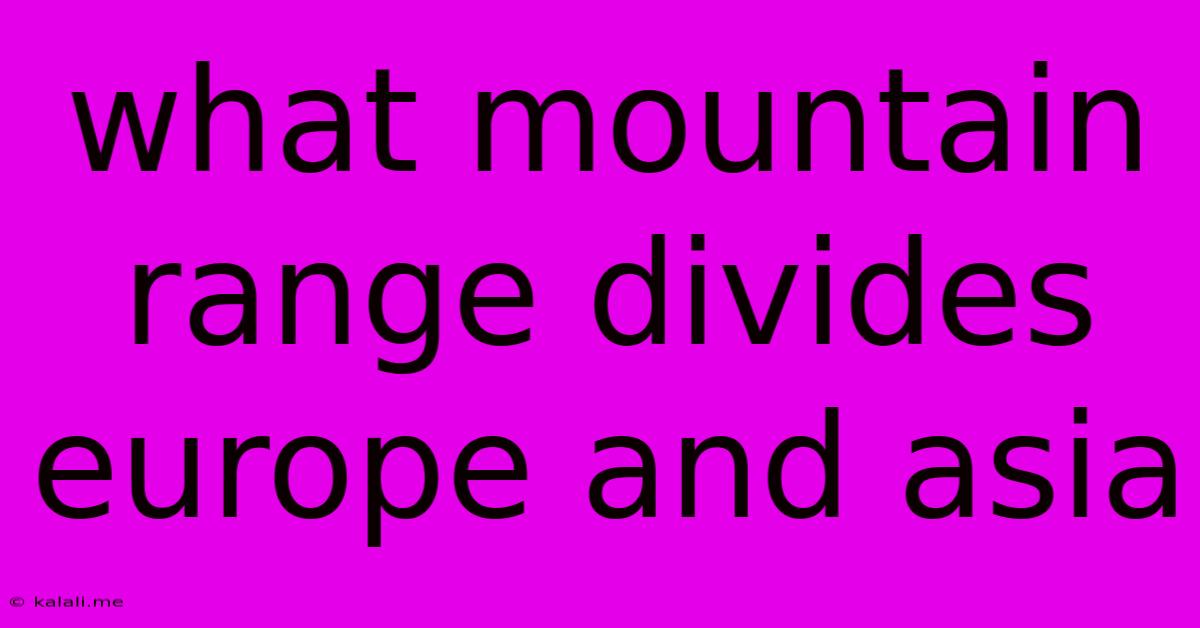What Mountain Range Divides Europe And Asia
Kalali
Jun 15, 2025 · 3 min read

Table of Contents
What Mountain Range Divides Europe and Asia? The Ural Mountains and More
The question of what mountain range divides Europe and Asia is a surprisingly complex one, lacking a single, universally accepted answer. While the Ural Mountains are often cited as the primary boundary, the demarcation is more nuanced and involves several geographical features. This article delves into the intricacies of this geographical puzzle, exploring the Ural Mountains and other contributing factors in defining the Europe-Asia border.
Meta Description: Discover the complexities of the Europe-Asia border. While the Ural Mountains are often cited, the division isn't so simple. This article explores the geographical features that define the boundary between these two continents.
The Ural Mountains: A Prominent Dividing Line
The Ural Mountains, stretching approximately 1,500 miles (2,500 km) from the Arctic Ocean to the Kazakh Steppe, represent the most widely recognized physical boundary between Europe and Asia. This vast mountain range offers a clear, albeit somewhat arbitrary, separation. Its geological formations, distinct flora and fauna, and historical significance all contribute to its role in defining the continental boundary. The eastern slopes of the Urals show a gradual transition into the vast Siberian plains, a clear shift in geographical character.
However, the Ural Mountains alone don't entirely capture the complexity of the Europe-Asia boundary. The line is not a straight, precisely defined geological feature. The natural transition zones found within the mountain range blur the lines, leading to differing interpretations of the continental divide.
Beyond the Urals: Other Contributing Factors
The delineation between Europe and Asia isn't solely determined by a single mountain range. Several other geographical features contribute to this complex boundary:
-
The Ural River: This river flows south from the Ural Mountains and is often considered a natural extension of the continental divide. It provides a watery boundary, continuing the separation initiated by the mountains.
-
The Caucasus Mountains: This imposing mountain range, home to Mount Elbrus, the highest peak in Europe, is located south of the Ural Mountains. While geographically part of Asia, some definitions extend the European boundary to encompass parts of the Caucasus due to cultural and historical factors. This is a key area of contention in defining the border.
-
The Caspian Sea: The Caspian Sea, the world's largest inland body of water, lies east of the Caucasus Mountains and is a significant geographical element influencing the Europe-Asia boundary. Its vast expanse further complicates the delineation.
-
The Black Sea and the Bosphorus Strait: These features connect the Black Sea to the Aegean Sea and ultimately the Mediterranean. They influence the perceptions of the boundary, but mainly in the context of the historical and cultural significance of the region.
-
Cultural and Political Boundaries: The geographical distinctions are further complicated by political and cultural boundaries. For example, some countries and regions, while geographically located in Asia, have strong European cultural ties, impacting the perception of the boundary.
The Arbitrariness of the Boundary
It's crucial to understand that the boundary between Europe and Asia is, to a large extent, arbitrary. There isn't a universally agreed-upon definition. Geographers, historians, and politicians have used different criteria and approaches over the centuries, leading to various interpretations of the continental divide. The lack of a distinct, continuous, and universally accepted boundary emphasizes the blurred lines between these two massive landmasses.
Conclusion: A Shifting Divide
In summary, while the Ural Mountains provide a dominant landmark for the Europe-Asia division, other geographical elements such as the Ural River and the Caucasus Mountains play significant roles. Ultimately, the boundary remains a subject of debate, highlighting the fluid and often arbitrary nature of continental boundaries and the challenges of applying strict geographical definitions to complex historical and cultural landscapes. The actual line is often a matter of convention rather than a definitive geological reality.
Latest Posts
Latest Posts
-
What Is The Sequence Of Blood Flow Through The Kidneys
Jun 16, 2025
-
What Two Oceans Does The Panama Canal Connect
Jun 16, 2025
-
The Study Of Earths Atmosphere Is Known As
Jun 16, 2025
-
Device That Converts Light Energy Into Electrical Energy
Jun 16, 2025
-
Which Of The Following Is An Interjection
Jun 16, 2025
Related Post
Thank you for visiting our website which covers about What Mountain Range Divides Europe And Asia . We hope the information provided has been useful to you. Feel free to contact us if you have any questions or need further assistance. See you next time and don't miss to bookmark.